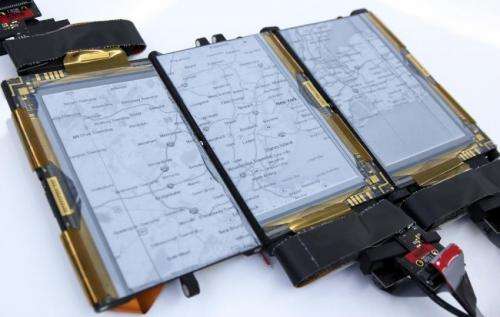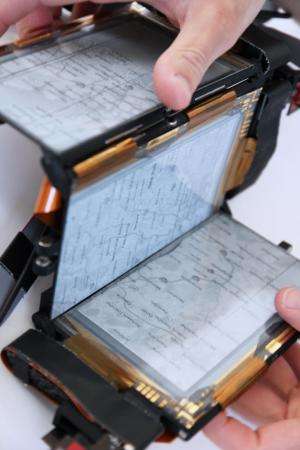May 2, 2014 weblog
Human Media Lab introduces shape-changing smartphone (w/ Video)

(Phys.org) —After hearing about the work at a premier media lab in Canada, suddenly"smartphone" becomes a very limiting word, incomplete in describing the instrument that has been created as a handheld map, book, menu or whatever else rendering of information you may need that just happens to have a phone function too. The Human Media Lab at Canada's Queen's University have come up with PaperFold, as a multi-display shape changing smartphone. The PaperFold uses up to three detachable display tiles. Each tile has a flexible E-ink display and flexible 3D-printed substrate with embedded sensors.
Lab student Antonio Gomes along with the labs Director, Roel Vertegaal have authored a paper on the creation that helps describe it: "PaperFold: A Shape Changing Mobile Device with Multiple Reconfigurable Electrophoretic Magnetic Display Tiles." The inspiration for PaperFold, fundamentally, came from paper and its potential in computing. "Typically, mobile devices require scrolling or zooming in order to see different parts of a document whereas paper can be folded, detached or combined allowing it to be accessed in multiple parallel forms," said the lab team's announcement.
Dr. Roel Vertegaal, Professor of Human-Computer Interaction HCI at Queen's University's School of Computing as well as lab director, expanded on what drove their research: "The development of electronic paper computers that can adopt similar qualities to paper has been an enduring research goal for our team," he said. "Books use folding as both a navigational and space saving technique, and paper maps have malleable display sizes. The PaperFold smartphone adopts folding techniques that makes paper so versatile, and employs them to change views or functionality of a smartphone, as well as alter its screen real estate in a flexible manner. PaperFold demonstrates how form could equal function in malleable mobile devices."
Just how this could enhance any kind of knowledge work becomes apparent in the team's list of PaperFold options. The three flexible electrophoretic displays provide extra space when it is ever needed. One can move from an ultra notebook shape to a foldout map. If the user folds the device into an ultra notebook form factor then there is a keyboard on the bottom screen. Users can in turn type a search. Flatten the three displays and you may study a Google map spanning all screens. PaperFold can automatically recognize its shape and change its graphics to provide different functionality upon shape changes.

While PaperFold is not yet headed for the retail shelves, its technology is valued as showing what is possible with digital displays, E-ink technology, and the very future of foldable smartphones. In a larger view, Vertegaal's current interest is in Organic User Interface, or OUI. "In the near future," he stated, "a computer will have any shape or form, and flexible computer displays will start appearing on any product of any form. These Organic User Interfaces will be completely embedded in real world interactions."
More information:
— www.hml.queensu.ca/
— www.hml.queensu.ca/blog/paperfold
© 2014 Tech Xplore




















